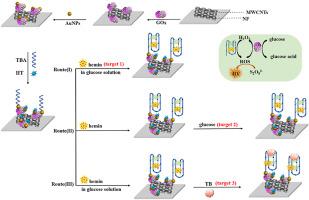Talanta ( IF 5.6 ) Pub Date : 2022-08-01 , DOI: 10.1016/j.talanta.2022.123788 Mei-Ling Liu 1 , Xiao-Jing He 1 , Yi Li 1 , Mei-Ling Zhao 2 , Ying Zhuo 2

|
As various aptasensors are adopted in clinical diagnosis, the development of convenient multiple-target determination is a field of ever-increasing interests. Herein, a label-free and amplified electrochemiluminescence (ECL) sensing platform was constructed to detect multiple targets of hemin, glucose and thrombin (TB) using peroxydisulfate (S2O82−) solution, which was one of the most convenient and economical ECL systems. It was worth mentioning that the target-induced bi-enzyme cascade catalysis reaction was developed to increase the ECL response strongly of S2O82− solution due to the production of (1O2)2* from the inter-reaction between reactive oxygen species (ROS) and sulfate radical (SO4•−). Specifically, with the layer-by-layer assembly of multi-walled carbon nanotubes (MWCNTs), glucose oxidase (GOx) and gold nanoparticles (AuNPs) as the interface, the guanine-rich (G-rich) thrombin aptamer (TBA) was anchored for hemin (target 1) detection, due to the electrocatalysis of hemin/G-quadruplex as a horseradish peroxidase mimicking DNAzyme (HRP-DNAzyme) towards dissolved oxygen for ROS generation. Second, in the presence of glucose (target 2), the ECL intensity was improved because glucose was the substrate of the bi-enzyme cascade catalysis reaction. Third, when TB (target 3) was sequentially incubated based on the above-mentioned aptasensor, the bi-enzyme catalysis was inhibited to decrease the ECL signal, due to the steric hindrance effect of the TB protein. As a result, the aptasensor achieved the nanomolar detection for hemin (3.33 nM), the micromolar detection for glucose (0.33 μM) and the femtomolar detection for TB (3.33 fM), respectively.
中文翻译:

一种使用过硫酸盐溶液进行多靶点电化学发光检测的简便经济策略
随着各种适体传感器在临床诊断中的应用,方便的多靶点测定的发展是一个越来越受关注的领域。本文构建了一种无标记的放大电化学发光(ECL)传感平台,使用过硫酸盐(S 2 O 8 2-)溶液检测血红素、葡萄糖和凝血酶(TB)的多个靶标,这是最方便、最经济的方法之一。 ECL 系统。值得一提的是,由于生成 ( 1 O 2 ) 2 ,开发了靶标诱导的双酶级联催化反应,以强烈增加 S 2 O 8 2-溶液的 ECL 响应。* 来自活性氧 (ROS) 和硫酸根 (SO 4•−)。具体而言,以多壁碳纳米管(MWCNTs)、葡萄糖氧化酶(GOx)和金纳米颗粒(AuNPs)为界面,逐层组装形成富含鸟嘌呤(G-rich)的凝血酶适体(TBA)。由于血红素/G-四链体作为辣根过氧化物酶模拟脱氧核糖核酸酶(HRP-脱氧核糖核酸酶)对溶解氧产生 ROS 的电催化作用,锚定用于血红素(目标 1)检测。其次,在存在葡萄糖(目标 2)的情况下,由于葡萄糖是双酶级联催化反应的底物,因此 ECL 强度得到了提高。第三,当基于上述适体传感器连续孵育TB(靶标3)时,由于TB蛋白的空间位阻效应,双酶催化被抑制,ECL信号降低。结果,适体传感器实现了对血红素的纳摩尔检测(3.











































 京公网安备 11010802027423号
京公网安备 11010802027423号